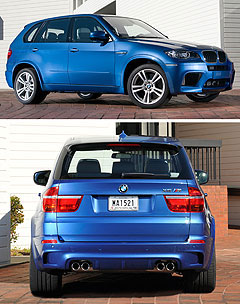Future models - BMW - X5 - MBMW vows to launch blistering X5 M early in 2010Killer watt: BMW's forthcoming X6 M will be powered by a 408kW twin-turbo V8. BMW’s X5 M SUV to join X6 M in Australia, priced from around $180K20 Jul 2009 By TERRY MARTIN BMW Group Australia has done a backflip over its X5 M high-performance SUV, announcing a January 2010 arrival alongside its X6 M twin after initially vowing not to introduce it Down Under. The Bavarian marque this week confirmed that both V8-powered AWD SUVs will be priced from around $180,000, with the first customer deliveries of the X6 M taking place late in December, a few weeks ahead of the X5 equivalent. Attempting to muscle in on the market niche that has proven lucrative for Mercedes-Benz and Porsche, BMW’s first M-division SUVs feature a modified version of the 4.4-litre twin-turbocharged petrol V8, which in this application produces 408kW at 6000rpm and 680Nm from 1500-5650rpm. The so-called ‘M TwinPower Turbo’ drives all four wheels through an M Sports six-speed automatic transmission, enabling the 2.38-tonne X5 M to accelerate from 0-100km/h in 4.7 seconds and reach a (governed) top speed of 250km/h – or 275km/h with an optional M Driver’s Package fitted.  Fuel consumption is rated at 13.9L/100km combined, or 19.3L/100km when confined to urban areas, while CO2 emissions are 325g/km. Fuel consumption is rated at 13.9L/100km combined, or 19.3L/100km when confined to urban areas, while CO2 emissions are 325g/km.Among the chassis highlights are the standard fitment of air suspension, adjustable dampers and ‘active’ anti-roll control, while braking hardware includes four-piston callipers clamping on to 395mm diameter vented discs at the front, and single-piston callipers gripping 385mm vented rotors at the rear. While on the subject of braking, BMW Australia this week told GoAuto that no X5 or X6 models delivered to Australian customers are affected by a safety recall in the US, in which all 2009 models of both SUVs are being called back into dealers for a brake check.. According to a recall notice issued last week by the National Highway Traffic Safety Administration (NHTSA), the rear brake discs might not have been manufactured according to specifications. “As a result, a reduction in braking performance at the affected rear wheel could occur,” the notice said. “In an extreme case, the affected rear brake disc could break, resulting in a loss of braking at that wheel, increasing stopping distances and the risk of a crash.”  Read more6th of April 2009  First look: BMW X6 gets the M treatmentBMW succumbs to the high-performance SUV trend with new X6 and X5 M variants22nd of January 2009  BMW 2009 X6 xDrive50iBMW has bolted twin turbos on to the X6's V8, pumping out 600Nm of torque22nd of January 2009  First Oz drive: Blown Beemer on the paceBMW's first twin-turbo V8 propels bulky X6 to 100km/h in just 5.4 seconds24th of October 2008  High-five for M-look X5BMW waves its M wand over the X5 for the first time, but it’s more show than go16th of July 2008  BMW 2008 X6 5-dr wagon rangeBMW’s X6 combines an SUV with coupe styling, twin-turbo oomph and sportscar dynamics16th of July 2008  First drive: BMW's coupe de grassBMW delivers an SUV with coupe looks and sportscar performanceX5 pricing
Motor industry news |
Click to shareBMW modelsX5 pricing
Motor industry news |
















Facebook Twitter Instagram